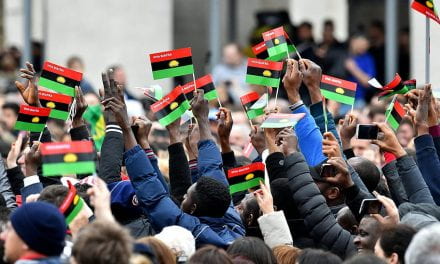In October 2018, during a WAFF Women’s Club Championship match between Jordan’s Shabab al Ordon Club and Arab Orthodox Club, an unnamed player for the Arab Orthodox Club was knocked during a play which shifted her hijab, an Islamic head covering for women, and exposed part of her hair. The hijab is worn out of choice to express modesty and for many women who veil, being uncovered in public is akin to being naked. Disregarding the game, the player dropped to the ground to try to re-cover her hair and in a moving show of solidarity, the women from the opposing team huddled around the player to protect her privacy as she recovered herself. [i]No whistle was blown, yet all action of the game ceased. This was not just an act of sportsmanship, but an act of cultural and religious empathy. The Jordanian team did not veil themselves, but they showed compassion for a tradition of Islam, demonstrating the model of respect that one can only hope for when a part of the minority.
The hijab covers just the hair and neck, the niqab fully covers the head, neck, and shoulders, leaving only the eyes uncovered, and the burqa does the same, but additionally covers the entire body. In France, all of these garments are banned in state-run schools and government properties. While the stated intention of the French government is to increase equality by reducing bias and discrimination caused by visual displays of religiosity, the ban acts as a thinly veiled excuse for Islamophobia and xenophobia. The French secular policies are applicable to all religions, but primarily targets Muslims as their religion is visible through cultural garments and traditional grooming standards. As the French government expands the ban on religious symbols, it becomes increasingly obvious that French Muslims are not desirable citizens of France, and the state will only hold space for them in the community if their Islamic roots are suppressed.
Secularism, or laïcité, is a founding principle of the French Republic, whose aim was to reduce the appearance of religiosity through “assimilation of all to one ‘legitimate’ culture.”[ii] The separation of church and state was formalized in 1905 to achieve political unity, and in turn, cultural unity. Today, many Europeans “equate modernity with secularity and see religiosity…[as] backward[s].”[iii] After the decolonization wave that followed WWII, immigration for labor jobs from former French colonies steadily increased the Muslim population in France. As Islam grew in popularity, French discontent and public anxiety increased. In the 1980s, French media portrayed Islam as akin to global fundamentalism and terrorism, thus contributing to the narratives that feed Islamophobia . The visible expression of practicing Islam through veiling and traditional clothing made private religion public and was interpreted as a “conflict to France’s secular tradition.”[iv]
In the late 20th century, tensions related to secularism escalated in public schools. In 1989, three girls were expelled from a Paris middle school for wearing hijabs in what became l’Affaire des foulards. While the court found that their expulsion was illegal, the controversy opened the discussion of public expression of religion in schools, and specifically Islamic expression. In 2003, French President Jacques Chirac created the Stasi Commission, named after the chair Bernard Stasi, to investigate laïcité as he believed that people were “hiding behind an aberrant conception of religious freedom in order to defy the laws of the Republic.”[v] The Commission found that girls wearing headscarves “should be considered a vector for proselytism and a disruption to education’s tranquility,”[vi] and that banning them would also be a positive step for women’s rights. Commission member Alain Juppé of the right wing party went further to say that veiling in schools was a “militant act which is supported by real fundamentalist propaganda.” [vii] Unfortunately, his opinion was in the majority.
In 2004, the French parliament passed a bill banning “conspicuous religious symbols in schools,” such as large crosses, kippahs, and mainly hijabs.[viii] It must be noted that small cross and Star of David pendants remained acceptable. Later in 2010, full face veils were made illegal in public, not just in schools. Most recently, in August 2023, the French government expanded their policy of laïcité by banning the abaya, which is a traditional loose dress often worn by Muslim women.[ix] While the strict separation of church and state in France is a response to the dominant Catholic influence in French politics prior to the 19th century, the modern interpretation of laïcité is an exploitation of French cultural tradition and is demonstrative of mounting Islamophobia and the power of the government to enable it.
At a news conference in August, Education Minister Gabriel Attal explained the most recent ban, saying “our schools are continually put under test, and over the past months, breaches to laïcité have increased considerably,”[x] and “when you walk into a classroom, you shouldn’t be able to identify the pupils’ religion just by looking at them.”[xi] In protest, approximately 300 girls defied the ban and wore the abaya to school. Sixty-seven refused to change and were inevitably sent home in suspension.[xii] On September 7th, the French Supreme Court of administrative affairs, the Conseil d’Etat, upheld the government ban after a complaint was filed by the group Action for the Rights of Muslims. The complaint was that the ban was “discriminatory” and that it could “incite hatred” against young Muslim women. They also argued that the abaya is a traditional garment, not a religious one. However, the court ruled that wearing the abaya“follows the logic of religious affirmation,” and is prohibited under French secularism law.[xiii]
Despite the decision, criticisms that France’s policies of laïcité unfairly discriminate and target Muslims continue to increase. On September 8th, Clementine Autain, a leftist politician in France, called the ban an “obsessional rejection” of Muslims.[xiv] On the same day, the US Commission on International Religious Freedom denounced the ban as well. The Chair of the Commission, Abraham Cooper, said that the ban was a “misguided effort to promote the French value of laïcité,” and meant to “intimidate” French Muslims.[xv] The effects of the ban also have tangible negative consequences. If female students defy any of the bans, they are first removed from classes to discuss alternatives to their modest clothing. If they continue to veil, or wear the abaya, they are expelled. From there, their options are to switch to a private school, pursue distance learning, emigrate, or if older than 16, they may drop out of school.[xvi]
In a 2021 study, Muslim girls were interviewed on their experiences with the bans. One respondent stated that she “reveals [herself] in classes because [she] has no choice, because getting a diploma is important.” Another addressed that the misogyny of banning headscarves comes from a lack of understanding and an outdated colonial mindset that Muslim women are oppressed and must be saved. She said that “i t bothers me a lot when people speak to us as if all these laws are made to free us while we are very, very free as we are. Wearing [the headscarf] is our freedom and so is not taking it off.”[xvii] If women or girls wearing traditional clothing is politicized as being representative of an “oppressive” Islam, as it is today, then the French government may claim that the policies are liberation, not discrimination. In reality, what France considers liberation by its own standards of righteousness is in fact harmful to the lasting security and freedom of Muslims in France. Muslims, and primarily women, are not able to freely express their religion and culture without fear of prosecution.
So, despite the intentions driving French secularism policies, France’s prescription for equality is poisonous. The enforcement of laïcité in public schools is an abuse of civil liberties and a justification for the legalization of Islamophobia. This illiberalism, or institutional restrictions on civil liberties, of France is antithetical to religious freedom and women’s rights and unfairly targets Muslims in France. From laïcité, comes oppression.
[i] Annie Reneau, “Opposing Team Members Surrounded a Soccer Player Whose Hijab Came Off, and It’s Fabulous – Upworthy,” www.upworthy.com, March 9, 2019, https://www.upworthy.com/opposing-team-members-surrounded-a-soccer-player-whose-hijab-slipped-and-its-fabulous.
[ii] Jane Freedman, “Secularism as a Barrier to Integration? The French Dilemma,” International Migration 42, no. 3 (August 2004): 5–27, https://doi.org/10.1111/j.0020-7985.2004.00287.x.
[iii] Rogers Brubaker, “A New ‘Christianist’ Secularism in Europe,” SSRC The Immanent Frame, October 11, 2016, https://tif.ssrc.org/2016/10/11/a-new-christianist-secularism-in-europe/.
[iv] Aala Abdelgadir and Vasiliki Fouka, “Political Secularism and Muslim Integration in the West: Assessing the Effects of the French Headscarf Ban,” American Political Science Review 114, no. 3 (May 12, 2020): 1–17, https://doi.org/10.1017/s0003055420000106.
[v] Freedman, “Secularism as a Barrier,” 5–27.
[vi] Jonathan Hauser, “Education, Secularism, and Illiberalism: Marginalisation of Muslims by the French State,” French Cultural Studies 32, no. 2 (April 22, 2021): 095715582110074, https://doi.org/10.1177/09571558211007444.
[vii] Freedman, “Secularism as a Barrier,” 5–27.
[viii] Abdelgadir and Fouka, “Political Secularism,” 1–17.
[ix] Juliette Jabkhiro, “French Ban of Abaya Robes in Schools Draws Applause, Criticism,” Reuters, August 29, 2023, sec. Europe, https://www.reuters.com/world/europe/french-ban-abaya-robes-schools-draws-applause-criticism-2023-08-28/.
[x] Ibid.
[xi] Michel Rose, “France to Ban Muslim Abaya Dress in State Schools,” Reuters, August 27, 2023, sec. Europe, https://www.reuters.com/world/europe/france-ban-muslim-abaya-dress-state-schools-2023-08-27/.
[xii] Le Monde, “French Court Upholds Abaya Ban in Public Schools,” Le Monde.fr, September 7, 2023, https://www.lemonde.fr/en/education/article/2023/09/07/french-court-upholds-abaya-ban-in-public-schools_6128068_104.html.
[xiii] Le Monde, “French Court,”
[xiv] Jabkhiro, “French Ban of Abaya Robes,”
[xv] AFP-Agence France Presse, “US Panel Denounces France Abaya Ban as Targeting Muslims,” www.barrons.com, September 8, 2023, https://www.barrons.com/news/us-panel-denounces-france-abaya-ban-as-targeting-muslims-952792e5.
[xvi] Abdelgadir and Fouka, “Political Secularism,” 1–17.
[xvii] Hauser, “Education, Secularism, and Illiberalism,”







